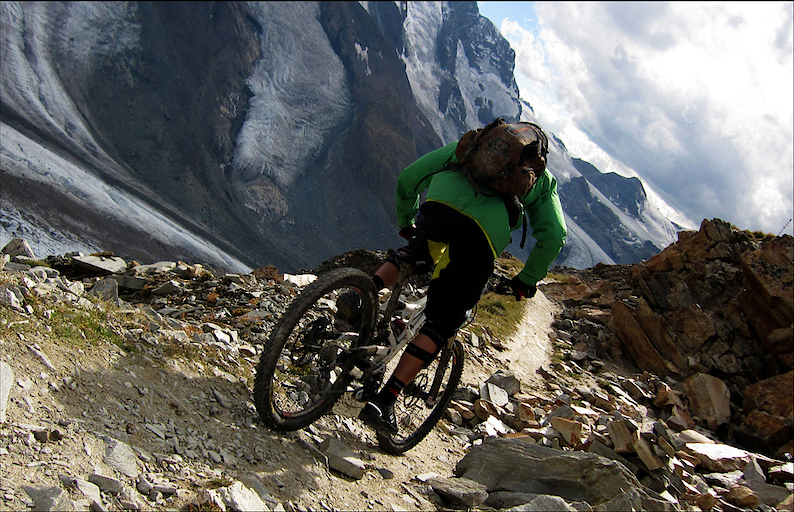
After doing our research and figuring out the best route, we get the go-ahead from our guide, mountaineer Olivier, who confirms that it is feasible to ride across the glaciers that cover the mountainside. At last, after several false starts, a day dawns when both snow and weather conditions are perfect – this is our chance!
We wake at sunrise to make the ascent. The first part isn’t too taxing – we take the Klein Matterhorn cable car up to 3,820m – but that still leaves nearly 350m of vertical ascent to the summit. We strap on crampons, rope up and I put my bike on my back. Fellow climbers greet us with friendly waves and looks of bemusement as we slowly make our way up the glacier. The climb is important because we have to scope out the best route for our descent. From the three options available, we choose the most direct line because it allows me to ride right from the top.
Into the unknown
When we reach the summit we’re surprised to find ourselves alone, and take in the spectacular panorama across the snowcovered peaks. The moment I’ve been anticipating for so long has arrived. It’s time to see if I can make it down the steepest part of the mountain. I don my body armour and helmet, then release the brakes. I feel like I’m flying as I speed along the ridge – the 1,000m drop into emptiness on my right helping to keep me focused.
The next section across the glacier is trickier. Olivier gives me some final instructions and tells me to wait for him to scout the best place to cross the crevasse. The gradient is so steep that he soon disappears out of view. Fortunately, Patrick and our videographer Floriane are just a little lower and indicate the line to follow.
At first I cover my brakes, but the snow is ideal and I’m able to hold my line. My racing heartbeat calms and I start to enjoy the moment. Once past the steepest part, I lay off the brakes and carve my way down the slope, through snow that seems to have been prepared just for me – it’s so exhilarating!
Thomas Frischknecht and Lukas Stockli rode this downhill some years ago, but they did it secured by a rope. Today the conditions are so good that I get to ride across the same plateau to the Klein Matterhorn, where some of my family are waiting for me. They were able to watch my descent, and it makes me happy to be able – for once – to share my experience with them.
All thrills, no spills
From here I slalom down slopes where several national ski teams train. At Trockener Steg, 400m lower, I meet my mechanic, Antoine, for a wheel change. There’s still nearly 2,500m of vertical descent to go, and I don’t want to be riding it on spikes. The temperature is warmer now and large slabs of rock appear through the snow. Although there are still some snowfields to cross, the path is clearly visible and it’s a blast to ride. I can already see the first pastures and the valley that leads to Visp, the final goal of the day.
But I can’t relax just yet, because some sections below Black Lake are steep, rocky and hug the edge of a cliff. Fortunately, apart from a puncture, I have no mishaps. From Tasch, at 1,450m altitude, the descent is punctuated by short climbs. The toughest takes me almost 200 vertical metres up a slippery slope so steep I have to push. It’s worth it though because the trail overlooks the valley and the evening sunlight adds a touch of magic.
Finally, at the end of a truly epic day, I roll into Visp, where Patrick and Floriane are waiting with a bottle of Champagne. I pop the cork, to the amusement of passers-by, and celebrate a fantastic ride – 3,513m of vertical descent in a day, now that’s mountain biking!
How to Ride Down a Glacier
To make it down the mountain in one piece, we knew we’d need perfect snow and favourable weather. Our most important consideration was the snow. We couldn’t ride on fresh powder – it had to be hard but not icy and the surface needed to be relatively smooth. Our first attempt was in late May and finally, after three postponements, we made the descent in mid-July, using spiked tyres at the top of the mountain and then swapping wheels for the rocky lower slopes.
WHAT IS THE BREITHORN?
The Breithorn is a mountain in the Pennine Alps that straddles the border between Switzerland and Italy. It has multiple peaks – the western summit is the highest at 4,164m and is where Alban started his descent – and a large number of glaciers and crevasses. The area breeds hardy locals: one mountain guide, Ulrich Inderbinen, was still climbing the Breithorn when he was 95.
http://allarroundmtb.blogspot.com/
More interesting here: http://allarroundmtb.blogspot.com/search/label/ARTICLES
Article Source: http://EzineArticles.com/?expert=T._Artemiev


